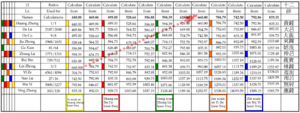Chinese musical system facts for kids
The ancient Chinese musical system is really interesting! It uses very old math to figure out how different musical sounds are made. This system is quite different from the music we usually hear today. Let's explore how it works.
Contents
Building an Ancient Chinese Instrument
The Basic Box
Imagine you want to build a special musical instrument. It's like a long wooden box. First, you'd make a box about 105 cm long and 60 cm wide. Then, you'd add guides for the strings at each end. These guides would be 99 cm apart.
Finding the Fret Spots
Now for the clever part: finding where to put the frets! Frets are like little ridges that change the sound of a string. The ancient Chinese used a special math trick to place them.
- Start with the 99 cm distance between the string guides.
- Multiply 99 cm by 2/3. This gives you 66 cm. You'd place the first fret at this 66 cm mark.
- Next, multiply 66 cm by 4/3. This equals 88 cm. Place the second fret here.
- Then, multiply 88 cm by 2/3. This is about 58.67 cm. Place the third fret.
- Keep going! You multiply the last fret's distance by either 4/3 or 2/3.
- Sometimes, if the number gets too small, you double it to keep the frets spaced out.
- You would keep doing this until you have placed eleven frets in total.
This careful math helps create specific musical notes when you press a string against a fret.
Making Music with Frequencies
What are Frequencies?
When you pluck a string, it vibrates. How fast it vibrates is called its frequency. A higher frequency means a higher sound, and a lower frequency means a lower sound.
Tuning the Strings
On an instrument built this way, each string can make 12 different sounds. This includes the sound of the open string (not pressed down) and the sounds made by pressing the string at each of the eleven frets.
To tune the instrument, you would:
- Tune the first string to a basic sound.
- Tune the second string to the sound of the first string when pressed at its first fret.
- Tune the third string to the sound of the first string when pressed at its second fret.
- You would continue this process for all twelve strings.
When all twelve strings are tuned, and you play all the fretted and unfretted positions, you get 144 different sounds! Some of these sounds might be the same, but many will be unique. This system is different from the Equal tempered system used in most Western music today.
Understanding Chinese Scales
What are Musical Scales?
A musical scale is a set of notes that sound good together. Think of "Do, Re, Mi, Fa, Sol, La, Ti, Do" – that's a scale!
Pentatonic and Heptatonic Scales
From the 12 sounds on each string, musicians can choose different groups of notes to make scales.
- Pentatonic scales use five different notes. "Penta" means five.
- Heptatonic scales use seven different notes. "Hepta" means seven.
The ancient Chinese system allows for many different choices of these five-note or seven-note scales.
Chinese vs. Western Scales
In Western music, like what you hear in many pop songs, we mostly use two main types of scales: the major scale (like "Do, Re, Mi...") and the minor scale.
However, traditional Chinese music uses five different kinds of five-note scales. This gives their music a very unique and beautiful sound compared to what we might be used to.


